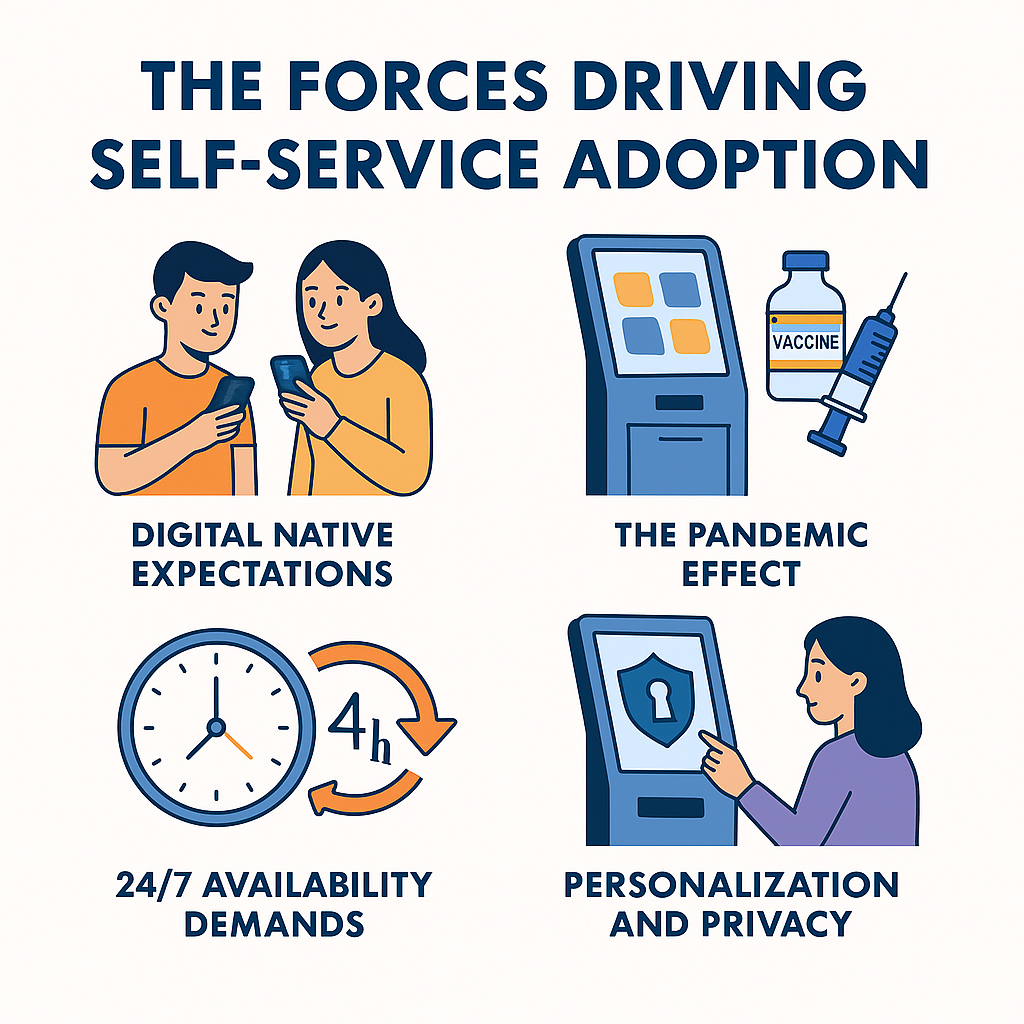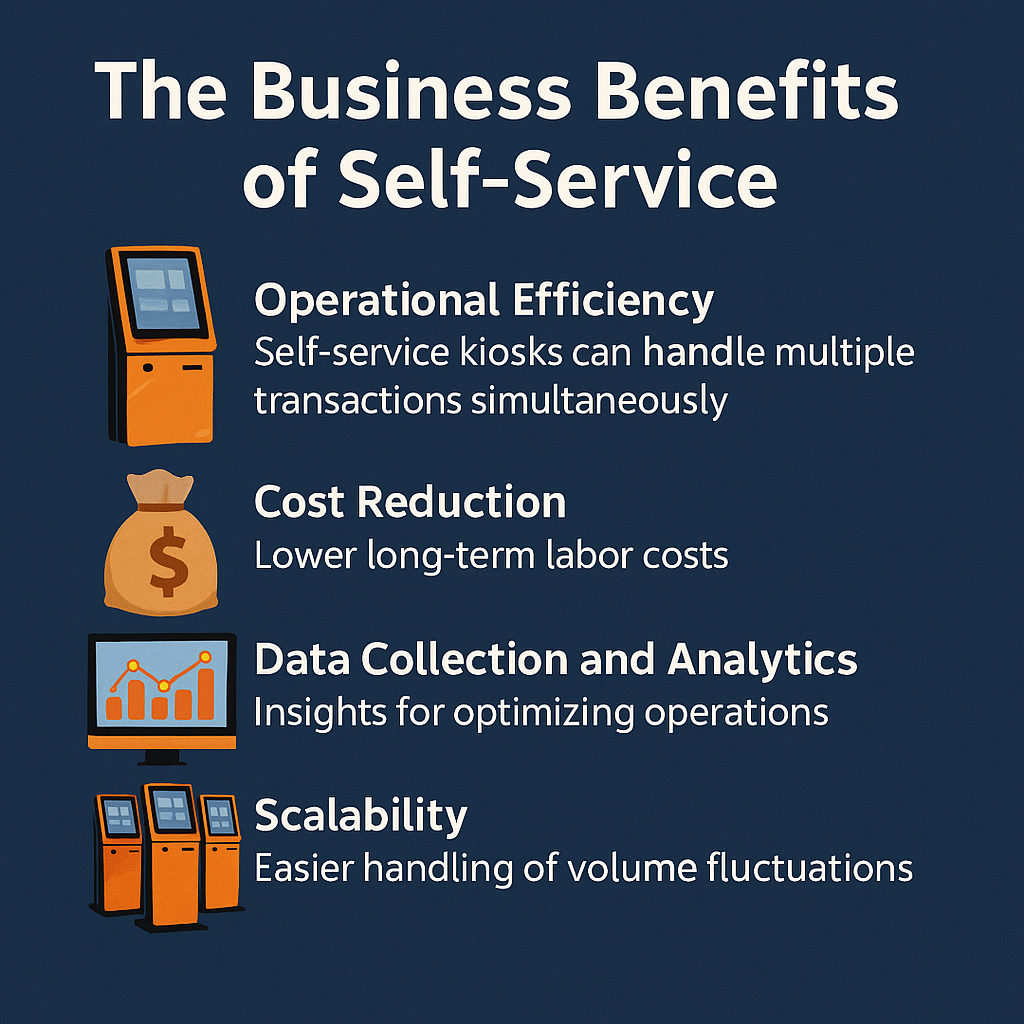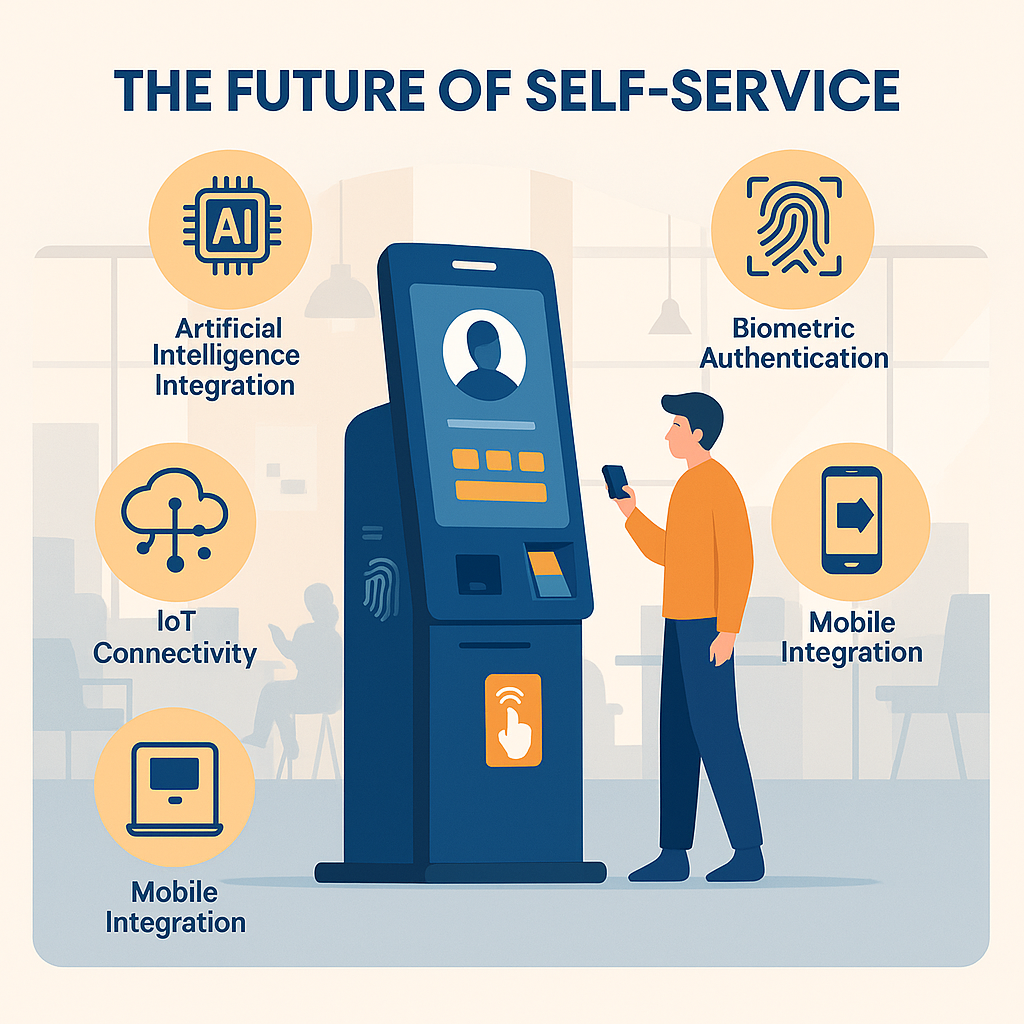The modern consumer has spoken, and their message is clear: they want control, convenience, and speed. Across every industry, from retail and hospitality to healthcare and government services, customers are increasingly gravitating toward self-service options that put them in the driver's seat of their experience.
This shift isn't just a trend—it's a fundamental transformation in how people prefer to interact with businesses. Understanding and adapting to this change has become essential for organizations looking to meet customer expectations and remain competitive in today's digital landscape.
The Forces Driving Self-Service Adoption
 Several converging factors have accelerated the demand for self-service solutions across industries.
Several converging factors have accelerated the demand for self-service solutions across industries.
Digital Native Expectations: Today's consumers, particularly millennials and Gen Z, have grown up with smartphones, apps, and instant access to information. They expect the same level of immediacy and control in their offline interactions that they experience online. For these digital natives, waiting in line for a human representative often feels unnecessary and inefficient.
The Pandemic Effect: COVID-19 dramatically accelerated self-service adoption by making contactless interactions not just convenient, but necessary. What began as a health precaution quickly revealed the efficiency benefits of self-service options. Many customers discovered they preferred the speed and autonomy these solutions provided, creating lasting behavioral changes that persist well beyond pandemic restrictions.
24/7 Availability Demands: Modern life doesn't operate within traditional business hours. Customers want to access services when it's convenient for them—whether that's 6 AM before work or 10 PM after putting the kids to bed. Self-service kiosks and automated systems provide round-the-clock availability that human-staffed operations simply can't match cost-effectively.
Personalization and Privacy: Self-service options often allow customers to take their time, review options thoroughly, and make decisions without feeling rushed or judged. This is particularly valuable in sensitive situations, such as healthcare check-ins or financial transactions, where privacy and discretion are important.
Self-Service Across Industries
The adoption of self-service technologies spans virtually every sector, each finding unique ways to enhance customer experience while improving operational efficiency.
Retail and Quick Service: Grocery stores have embraced self-checkout stations, while fast-food chains use ordering kiosks to reduce wait times and increase order accuracy. These solutions allow customers to browse menus at their own pace, customize orders precisely, and avoid miscommunication that can occur with verbal orders.
Healthcare: Patient check-in kiosks have revolutionized waiting room experiences, allowing patients to verify information, update insurance details, and complete forms digitally. This reduces administrative burden on staff while giving patients more control over their visit preparation.
Hospitality and Travel: Hotels offer self-service check-in kiosks that eliminate front desk queues, while airports deploy numerous self-service options for check-in, baggage tagging, and security document verification. These solutions are particularly valuable in high-volume environments where speed and efficiency are paramount.
Government Services: Municipal offices and DMV locations increasingly rely on self-service kiosks for routine transactions like permit renewals, fee payments, and information requests. This allows government workers to focus on complex cases that require human intervention while providing citizens with faster service for standard requests.
Entertainment and Events: Movie theaters, theme parks, and sports venues use self-service kiosks for ticket purchases, concession orders, and merchandise sales. These systems reduce staffing needs during peak times while eliminating bottlenecks that can negatively impact the customer experience.
The Business Benefits of Self-Service
 Organizations implementing self-service solutions report significant advantages beyond improved customer satisfaction.
Organizations implementing self-service solutions report significant advantages beyond improved customer satisfaction.
Operational Efficiency: Self-service kiosks can handle multiple transactions simultaneously without breaks, sick days, or varying service speeds. This consistency allows businesses to maintain service levels even during staff shortages or peak demand periods.
Cost Reduction: While the initial investment in self-service technology requires capital, the long-term savings in labor costs can be substantial. Staff can be redeployed to higher-value activities that require human expertise and creativity.
Data Collection and Analytics: Digital self-service interactions generate valuable data about customer preferences, peak usage times, and common service requests. This information enables businesses to optimize operations and make data-driven decisions about service offerings.
Scalability: Self-service solutions can handle volume fluctuations more easily than human-staffed operations. During busy periods, customers can use multiple kiosks simultaneously, while slower periods don't result in idle labor costs.
Overcoming Implementation Challenges
Despite the clear benefits, organizations must navigate several challenges when implementing self-service solutions.
User Experience Design: The interface must be intuitive enough for users of all ages and technical abilities. Poor design can create frustration and drive customers away from self-service options entirely. Successful implementations prioritize simplicity, clear navigation, and accessibility features.
Technology Integration: Self-service kiosks must integrate seamlessly with existing systems, from payment processors to inventory management and customer databases. This requires careful planning and often custom development to ensure smooth operation.
Maintenance and Support: Self-service systems require ongoing maintenance, software updates, and technical support. Organizations must plan for these operational requirements and have protocols in place for handling system outages or malfunctions.
Staff Training and Change Management: Employees need training on how to assist customers with self-service options and when to intervene. Managing the transition requires clear communication about how self-service enhances rather than replaces human jobs.
The Future of Self-Service
As technology continues to evolve, self-service solutions are becoming more sophisticated and capable of handling increasingly complex interactions.
 Artificial Intelligence Integration: AI-powered kiosks can provide more personalized recommendations, understand natural language queries, and learn from customer interactions to improve over time. This makes self-service options more helpful and engaging.
Artificial Intelligence Integration: AI-powered kiosks can provide more personalized recommendations, understand natural language queries, and learn from customer interactions to improve over time. This makes self-service options more helpful and engaging.
Biometric Authentication: Fingerprint scanners, facial recognition, and other biometric technologies are making self-service more secure while eliminating the need for cards, codes, or passwords.
IoT Connectivity: Internet of Things integration allows self-service kiosks to communicate with other systems and devices, enabling more comprehensive service offerings and better inventory management.
Mobile Integration: Customers increasingly expect to start transactions on their mobile devices and complete them at kiosks, or vice versa. This omnichannel approach provides maximum flexibility and convenience.
Meeting Customer Expectations
The rise of self-service reflects a broader shift in customer expectations around control, convenience, and efficiency. Businesses that recognize and adapt to this trend position themselves to deliver the experiences modern consumers demand.
However, successful self-service implementation isn't about replacing human interaction entirely—it's about providing customers with choices and using technology to enhance rather than diminish the overall service experience. The most effective approaches combine efficient self-service options with available human support when needed.
Organizations that embrace self-service solutions thoughtfully, with careful attention to user experience and integration with existing operations, will find themselves better equipped to meet evolving customer expectations while building more efficient and resilient business operations.
In our increasingly digital world, self-service isn't just an option—it's becoming an expectation. The businesses that thrive will be those that recognize this shift and implement solutions that truly serve their customers' desire for autonomy, speed, and convenience.

 Several converging factors have accelerated the demand for self-service solutions across industries.
Several converging factors have accelerated the demand for self-service solutions across industries. Organizations implementing self-service solutions report significant advantages beyond improved customer satisfaction.
Organizations implementing self-service solutions report significant advantages beyond improved customer satisfaction. Artificial Intelligence Integration: AI-powered kiosks can provide more personalized recommendations, understand natural language queries, and learn from customer interactions to improve over time. This makes self-service options more helpful and engaging.
Artificial Intelligence Integration: AI-powered kiosks can provide more personalized recommendations, understand natural language queries, and learn from customer interactions to improve over time. This makes self-service options more helpful and engaging.